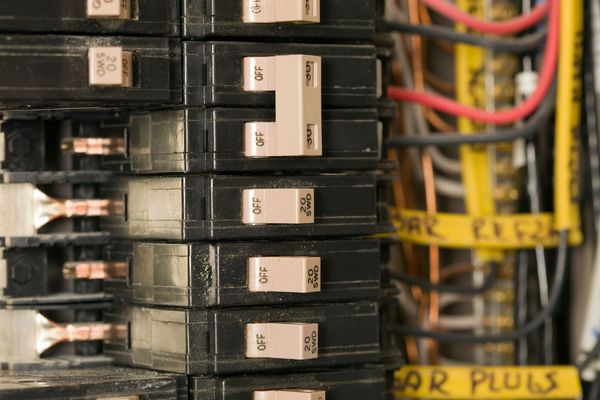TANDEM VS DOUBLE CIRCUIT BREAKER
Circuit breakers vary between manufacturers and styles. When choosing a circuit breaker, you need to know the different types of circuit breakers and what they are used for. Some circuit breakers are designed to service a single 120-volt circuit. These single-pole breakers take up only one space in the electrical panel.
Another type of circuit breaker is a double-pole breaker. Unlike the single-pole breaker, it services a 240-volt circuit by using two spaces in the electrical panel.
By utilizing both phases, you are able to connect the circuit breaker to things like a 240-volt air conditioner, an electric range, an electric water heater, or an electric dryer. Double-pole breakers have two connection points used to connect the electrical wires to them while snapping into place within the electrical panel's bus. The double-pole breaker has a unique bar across the two circuit breaker trip arms that simultaneously trip both phases of the circuit breaker, interrupting the power flow from it and shutting off the breaker. Without the bar, it is possible to trip one side of the breaker while leaving the other hot. Although I've seen it done, I wouldn't recommend placing a nail through the handle trip arms of two single-pole breakers to use them as a double-pole breaker.
Still, another circuit breaker is a tandem circuit breaker. It too has two connection points, but that is where the similarities part ways between it and a double-pole breaker.
What's is Tandem?
A tandem circuit breaker is a double circuit breaker that takes up the space of a single circuit breaker on a panel board.
You see, the tandem breaker is a divided single-pole breaker, servicing two different circuits. Although the trip handles are smaller, they still each are capable of protection two individual circuits. The other difference between it and the double-pole circuit breaker is that these two circuit breakers are built into on single space in your electrical panel.
A tandem circuit breaker is not always allowed in circuit breaker panels. Check first with your local electrical inspector to determine if using tandem breakers is acceptable. In most cases, an existing panel may have run out of usable space and a certain amount of tandem breakers are allowable. In new construction, this is not the case.
Since a tandem circuit breaker uses only one space, it is only using one phase of power. Keep in mind that if you are connecting a 12-3 wire with a ground to the panel, the black and red wires are sharing a neutral wire. These two hot wires, , the black and red wires, cannot be connected to the two tandem connection points, for you see these are connected to the same phase. One of the wires has to be connected to a circuit breaker on the other phase to share the neutral wire. Otherwise, if you are just connecting two separate single-circuit wires, this is the circuit breaker for you. The other downfall with the tandem circuit breaker is its lack of ability to take as much heat as a single circuit breaker. With two circuits encompassed in the same frame, each wire can heat the same circuit breaker while being under load.
In recap, a double-pole circuit breaker uses two spaces in your electrical panel and is used to connect a 240-volt feed to appliances and 240-volt receptacles used for high voltage connections.
A tandem circuit breaker uses only one space and is capable of supplying two, 120-volt circuits. It uses only one of the two phas but gives you two separate circuits in the space of one. If you're in a pinch for adding just one more circuit, this breaker can accommodate that need. I hope that helps to explain the similarities and differences between these two circuit breakers. Both are handy devices that add electrical safety to your home, they are just used to power different things in your home. When choosing circuit breakers, know what the amperage is on the appliance and whether the appliance is rated for 120 or 240 volts. Knowing how you are going to use the circuit breaker will greatly ease your shopping woes.






Comments
Post a Comment